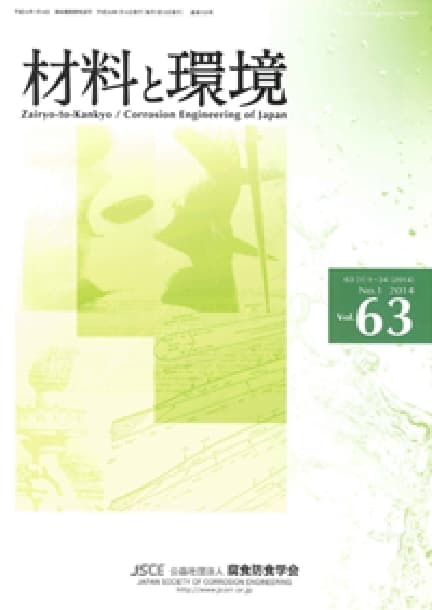材料と環境 Vol. 73 (2024), No. 7
Backnumber
-
Vol. 74 (2025)
-
Vol. 73 (2024)
-
Vol. 72 (2023)
-
Vol. 71 (2022)
-
Vol. 70 (2021)
-
Vol. 69 (2020)
-
Vol. 68 (2019)
-
Vol. 67 (2018)
-
Vol. 66 (2017)
-
Vol. 65 (2016)
-
Vol. 64 (2015)
-
Vol. 63 (2014)
-
Vol. 62 (2013)
-
Vol. 61 (2012)
-
Vol. 60 (2011)
-
Vol. 59 (2010)
-
Vol. 58 (2009)
-
Vol. 57 (2008)
-
Vol. 56 (2007)
-
Vol. 55 (2006)
-
Vol. 54 (2005)
-
Vol. 53 (2004)
-
Vol. 52 (2003)
-
Vol. 51 (2002)
-
Vol. 50 (2001)
-
Vol. 49 (2000)
-
Vol. 48 (1999)
-
Vol. 47 (1998)
-
Vol. 46 (1997)
-
Vol. 45 (1996)
-
Vol. 44 (1995)
-
Vol. 43 (1994)
-
Vol. 42 (1993)
-
Vol. 41 (1992)
-
Vol. 40 (1991)
キーワードランキング
17 Dec. (Last 30 Days)
材料と環境 Vol. 73 (2024), No. 7
Cu, Ti添加電縫鋼管の溝食抑制機構
原 卓也, 佐藤 淳, 中村 主志, 植森 龍治
pp. 168-174
DOI:
10.3323/jcorr.73.168抄録
In order to elucidate the grooving corrosion suppression mechanism of Cu and Ti added ERW steel pipes, welded portions were immersed in salt water after polishing without using the SPEED method, which electrolytically polishes the specimen using a non-aqueous electrolyte. Sulfides were observed using FIB processing. Before immersion, MnS and Ti4C2S2 were observed. After immersion, Cu7.2S4 precipitated on the MnS on the immersed surface. Furthermore, Ti4C2S2 did not dissolve. Addition of Ti produced insoluble Ti4C2S2, which reduced the number density of MnS, and addition of Cu precipitated insoluble Cu7.2S4 on MnS, suppressing the dissolution of MnS.
他の人はこちらも検索
材料と環境 Vol.73(2024), No.7
PEFC発電においてステンレス鋼セパレータの腐食により汚染されたMEAのToF-SIMSによる分析
箕浦 歩夢, 熊谷 昌信, 加澤 咲希, 白澤 瑠奈, 佐々木 颯斗, 八代 仁, 村瀬 正次
pp. 175-180
DOI:
10.3323/jcorr.73.175抄録
It has been pointed out that when stainless steel bipolar plates are used in PEFC, metal ions eluted due to corrosion contaminate the MEA and degrade cell performance. However, it was not clear whether the contamination mainly occurs from the anode side or the cathode side. In this study, a single cell was operated using bare type 304 stainless steel bipolar plates in contact with MEA and the cross sectional distribution of iron, chromium and nickel in the MEA was analyzed by ToF-SIMS. The results showed that iron, chromium and nickel were enriched in the anode side GDL and CCM. These results indicated that the leaching of metal ions from the anode side stainless steel bipolar plate was the main cause of MEA contamination.
他の人はこちらも検索
材料と環境 Vol.73(2024), No.7
論文アクセスランキング
17 Dec. (Last 30 Days)
-
大気腐食環境下における1700 MPa級調質ボルトの遅れ破壊機構
鉄と鋼 早期公開
-
Perspectives on the Promising Pathways to Zero Carbon Emissions in the Steel Industry toward 2050
ISIJ International Vol.65(2025), No.2
-
-
Factors Influencing the Bonding Phase Structure of Iron Ore Sinters
ISIJ International Vol.43(2003), No.9
-
-
-
Metallurgical Aspects on Interstitial Free Sheet Steel From Industrial Viewpoints
ISIJ International Vol.34(1994), No.1
-
Microstructures and Reduction Properties of High CaO Concentration Sintered Ore
ISIJ International 早期公開
-
Influence of Antimony on the Oxidation Characteristics of 65Mn Steel
ISIJ International 早期公開
-
この機能はログイン後に利用できます。
下のボタンをクリックしてください。










